Turning your office into a lush, green environment doesn’t just add aesthetic appeal; it also boosts productivity, improves focus, and enhances air quality. Whether you’re a seasoned plant enthusiast or a newbie to indoor greenery, selecting the right office plants makes all the difference. Factors like light availability, maintenance, and space constraints are vital when choosing the best plants for your workspace. Don’t worry—we’ve done the research for you.
Here’s a comprehensive list of the 13 best plants for your office that are easy to care for, fit in almost any workspace, and bring life to your work environment.
1. Snake Plant (Sansevieria trifasciata)
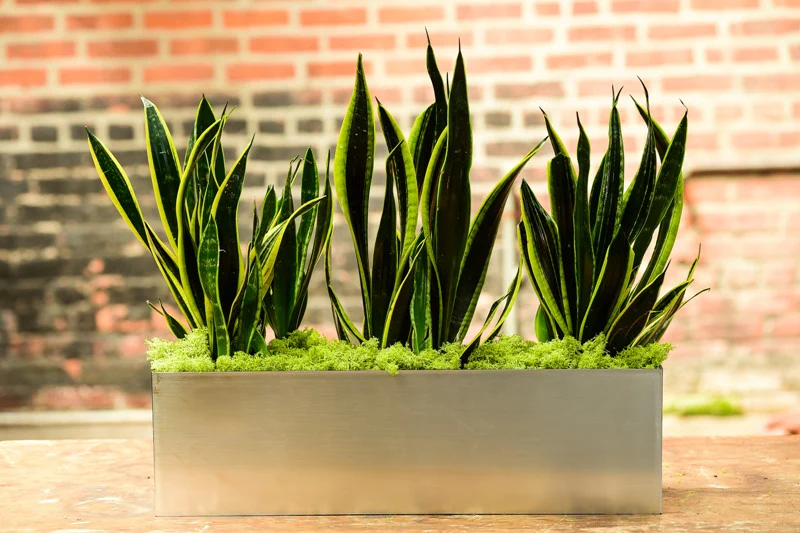
Snake Plant is one of the best plants for your office to creating a healthier and more stylish workspace. With its tall, sword-like leaves and striking green hues, it adds a modern touch to any office setup. This hardy plant is well-known for its ability to improve indoor air quality by filtering toxins like formaldehyde, benzene, and xylene. Snake Plant thrives in a variety of lighting conditions, from low light to bright indirect light, making it an excellent choice for offices with limited natural sunlight. Its low-maintenance nature means it can survive with infrequent watering, making it perfect for busy professionals.
Care Tips:
- Light Requirements: Thrives in low to bright indirect light, making it ideal for offices with artificial lighting.
- Maintenance Level: Extremely low; requires minimal attention and survives even in neglectful conditions.
- Watering: Water sparingly, only when the soil is completely dry. Overwatering can cause root rot.
- Soil: Prefers well-draining soil, such as a cactus or succulent mix, to prevent excess moisture retention.
- Humidity: Tolerates dry office air but benefits from occasional misting to remove dust and keep leaves fresh.
- Temperature: Adapts well to typical office temperatures, between 60-80°F (16-27°C). Avoid placing it near cold drafts.
- Cleaning: Wipe the leaves occasionally with a damp cloth to remove dust and maintain their air-purifying benefits.
- Pot Selection: Use a pot with drainage holes to prevent water from sitting at the roots.
2. Pothos (Epipremnum aureum)
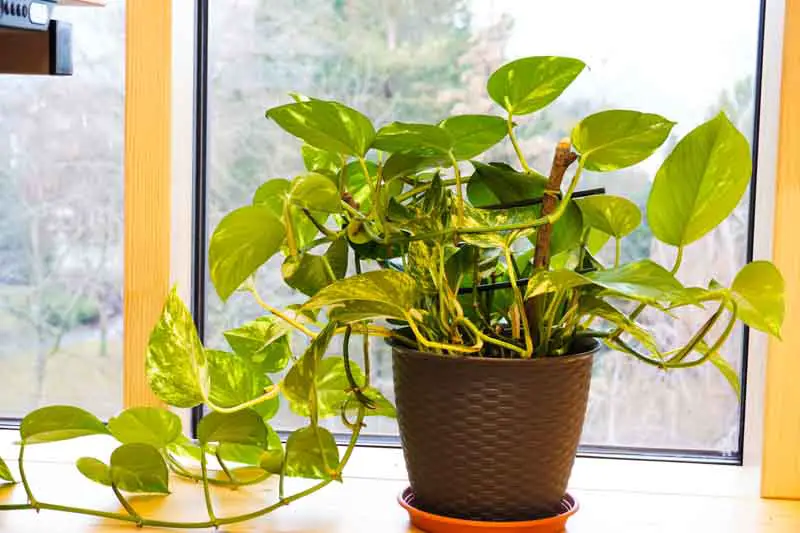
Pothos is one of the best plants for your office for beginners, thanks to its adaptability and low-maintenance nature. This vine-like plant adds a touch of greenery to workspaces with its cascading heart-shaped leaves, which thrive in a variety of lighting conditions. Whether placed in a hanging pot, allowed to trail over shelves, or trained to climb, Pothos brings a refreshing, lively feel to any office. In addition to its aesthetic appeal, it is a powerful air purifier, removing toxins like formaldehyde and benzene, making the office environment healthier.
Care Tips:
- Light Requirements: Grows well in low to moderate light, making it perfect for offices with artificial lighting.
- Maintenance Level: Low; thrives with minimal attention and care.
- Watering: Water when the top inch of soil feels dry. Avoid overwatering to prevent root rot.
- Soil: Prefers well-draining soil but can adapt to various potting mixes.
- Humidity: Tolerates dry air but flourishes in slightly humid conditions.
- Temperature: Grows best in temperatures between 65-85°F (18-29°C). Keep away from cold drafts.
- Pruning: Trim vines occasionally to promote bushier growth and maintain a tidy appearance.
- Propagation: Easily propagated by cutting a stem with a few leaves and placing it in water or soil.
- Cleaning: Wipe leaves regularly to remove dust and enhance their air-purifying ability
3. ZZ Plant (Zamioculcas zamiifolia)

ZZ Plant is one of the best plants for your office for low-light environments and busy professionals. With its glossy, emerald-green leaves, it adds a polished, modern touch to any workspace while requiring minimal care. This hardy plant is highly drought-tolerant, storing water in its rhizomes, which means it only needs watering every 2–3 weeks. ZZ Plant thrives in various lighting conditions, including low-light offices and even windowless spaces, making it an excellent choice for corporate settings. Additionally, it helps improve indoor air quality by filtering toxins, creating a healthier and fresher work environment.
Care Tips:
- Light Requirements: Tolerates low to bright indirect light, making it suitable for offices with limited natural sunlight.
- Maintenance Level: Minimal; thrives on neglect and requires very little attention.
- Watering: Water only when the soil is completely dry, approximately every 2–3 weeks. Overwatering can cause root rot.
- Soil: Prefers well-draining soil, such as a succulent or cactus mix.
- Humidity: Adapts well to dry office air, requiring no additional misting.
- Temperature: Best suited for office temperatures between 65-80°F (18-27°C). Keep away from cold drafts.
- Pot Selection: Use a pot with drainage holes to prevent excess moisture buildup.
- Cleaning: Wipe the leaves occasionally to remove dust and maintain their natural shine.
- Toxicity: ZZ Plant is toxic if ingested, so keep it out of reach of pets or small children in office spaces.
4. Peace Lily (Spathiphyllum)
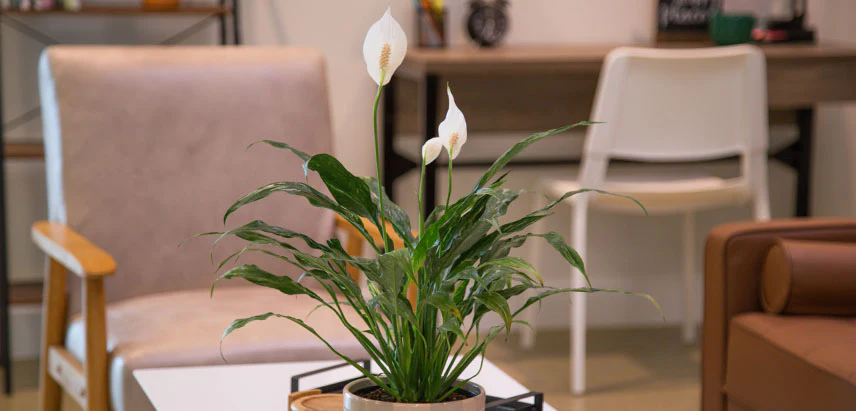
Peace Lily is one of the best plants for your office, offering a perfect blend of elegance and air-purifying benefits. With its lush green leaves and striking white blooms, it brings a sense of tranquility to any workspace. This beautiful plant is known for its ability to remove common indoor toxins, improving air quality and creating a fresher office environment. Peace Lily requires slightly more attention than some low-maintenance plants, as it prefers consistently moist soil and indirect light. However, its stunning appearance and health benefits make it a worthwhile addition to any office setup.
Care Tips:
- Light Requirements: Prefers moderate to bright indirect light but can tolerate lower light conditions. Avoid direct sunlight, which can scorch the leaves.
- Maintenance Level: Moderate; requires regular watering and care.
- Watering: Keep soil consistently moist but not soggy. Water when the top inch of soil starts to dry out.
- Soil: Thrives in well-draining, nutrient-rich potting soil.
- Humidity: Loves high humidity, so misting occasionally can help maintain its vibrancy.
- Temperature: Best suited for office temperatures between 65-80°F (18-27°C). Keep away from cold drafts and air conditioning vents.
- Cleaning: Wipe leaves with a damp cloth to remove dust and maintain their glossy appearance.
- Toxicity: Mildly toxic if ingested, so keep it out of reach of pets and children.
- Blooming: Produces elegant white flowers throughout the year with proper care, adding a sophisticated touch to your office space.
5. Spider Plant (Chlorophytum comosum)
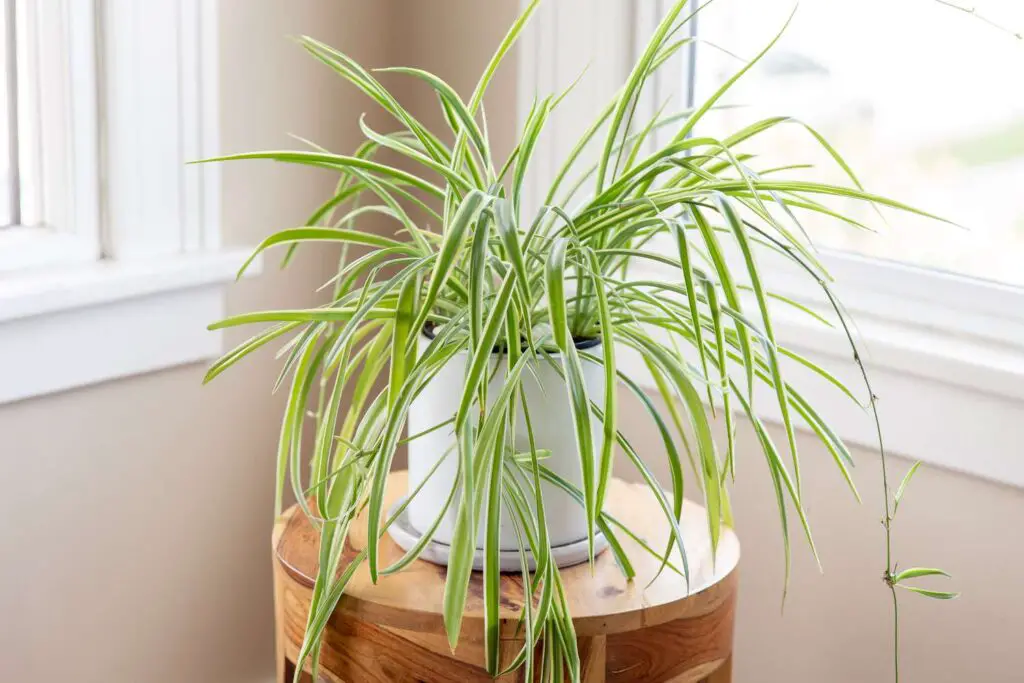
Spider Plant is one of the best plants for your office, combining style, resilience, and air-purifying benefits. With its arching green-and-white striped leaves, it adds a refreshing touch to any workspace, whether placed in a pot on a desk or in a hanging basket. This plant is highly adaptable, making it perfect for office environments where lighting and care routines may vary. Additionally, Spider Plant is known for removing airborne toxins like carbon monoxide and formaldehyde, helping to create a healthier office atmosphere.
Care Tips:
- Light Requirements: Thrives in bright indirect light but can tolerate lower light conditions.
- Maintenance Level: Very low; an excellent choice for beginners and busy professionals.
- Watering: Water when the top inch of soil feels dry. Avoid overwatering, as the roots store moisture.
- Soil: Prefers well-draining potting mix to prevent water retention.
- Humidity: Adapts well to office air but appreciates occasional misting to prevent brown leaf tips.
- Temperature: Grows best in office temperatures between 60-80°F (16-27°C). Keep away from cold drafts.
- Propagation: Produces small offshoots (“spiderettes”) that can be trimmed and propagated in water or soil.
- Cleaning: Wipe leaves occasionally to remove dust and enhance their air-purifying ability.
- Pet-Friendly: Non-toxic to pets, making it a safe choice for office environments with animals.
Related Topics:
17 Best Plants For Air Purification: Fresher, Healthier Home!
15 Best Plants for Terrariums: Greenery for Stunning Mini Ecosystems!
6. Succulents (Echeveria, Haworthia, etc.)
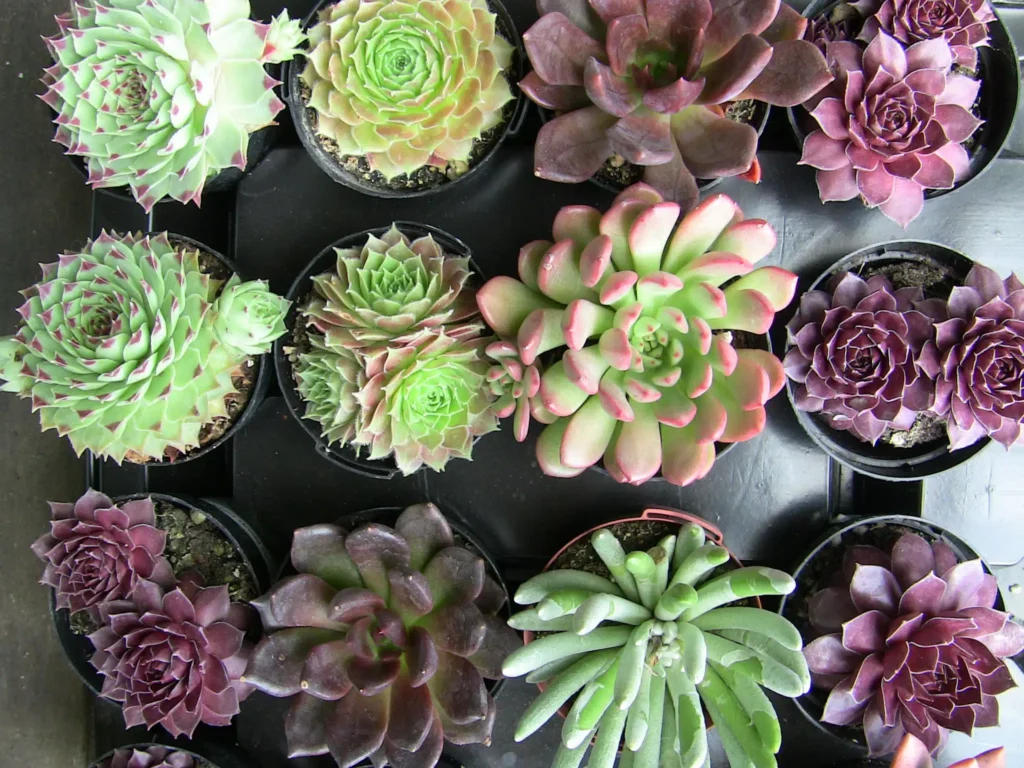
Succulents are among the best plants for your office, especially for those who prefer a low-maintenance yet stylish addition to their workspace. With their compact size and unique shapes, these plants fit perfectly on desks, shelves, or windowsills. Succulents store water in their thick leaves, allowing them to thrive with minimal watering, making them ideal for busy professionals. They also come in a variety of colors and textures, adding a decorative element to any office setup while requiring little attention.
Care Tips:
- Light Requirements: Prefer bright, direct to indirect light. Place them near a sunny window for best growth.
- Maintenance Level: Very low; perfect for those who tend to forget about watering.
- Watering: Water sparingly, about once every 2–3 weeks. Allow soil to dry out completely between waterings.
- Soil: Use well-draining cactus or succulent mix to prevent root rot.
- Humidity: Adapt well to dry office air and do not require additional misting.
- Temperature: Thrive in typical office temperatures between 65-80°F (18-27°C). Keep away from cold drafts.
- Pot Selection: Choose pots with drainage holes to prevent water buildup.
- Propagation: Easily propagated by leaf cuttings or offsets, making it simple to expand your plant collection.
- Cleaning: Wipe leaves gently to remove dust and keep the plant looking vibrant.
7. Rubber Plant (Ficus elastica)
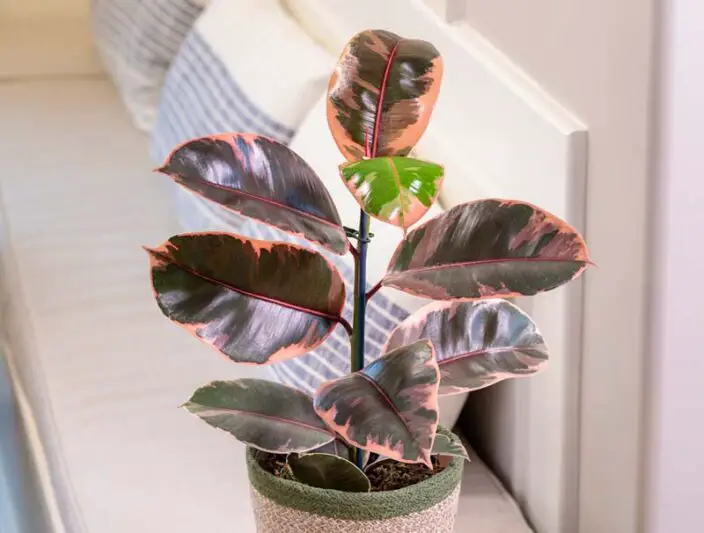
Rubber Plant is one of the best plants for your office, bringing a bold and sophisticated touch to any workspace. With its large, glossy leaves and rich green or burgundy hues, it makes a striking statement, whether placed in a pot on the floor or on a spacious desk. This plant not only enhances office aesthetics but also helps improve air quality by removing toxins. While it requires slightly more care than some other office plants, its stunning appearance and benefits make it a worthwhile addition.
Care Tips:
- Light Requirements: Prefers bright, indirect light. Can tolerate lower light but may grow more slowly.
- Maintenance Level: Moderate; requires regular watering and occasional pruning.
- Watering: Water when the top inch of soil is dry. Avoid overwatering, as soggy soil can cause root rot.
- Soil: Thrives in well-draining, nutrient-rich potting mix.
- Humidity: Prefers moderate to high humidity; occasional misting helps prevent dry leaf edges.
- Temperature: Best suited for office temperatures between 65-80°F (18-27°C). Keep away from cold drafts and air conditioning vents.
- Pruning: Trim occasionally to maintain shape and encourage bushier growth.
- Pot Selection: Use a pot with drainage holes to prevent excess moisture buildup.
- Cleaning: Wipe leaves regularly to remove dust and maintain their glossy appearance.
- Growth Potential: Can grow up to six feet tall indoors, making it a great choice for filling empty office corners.
8. Bamboo Palm (Chamaedorea seifrizii)
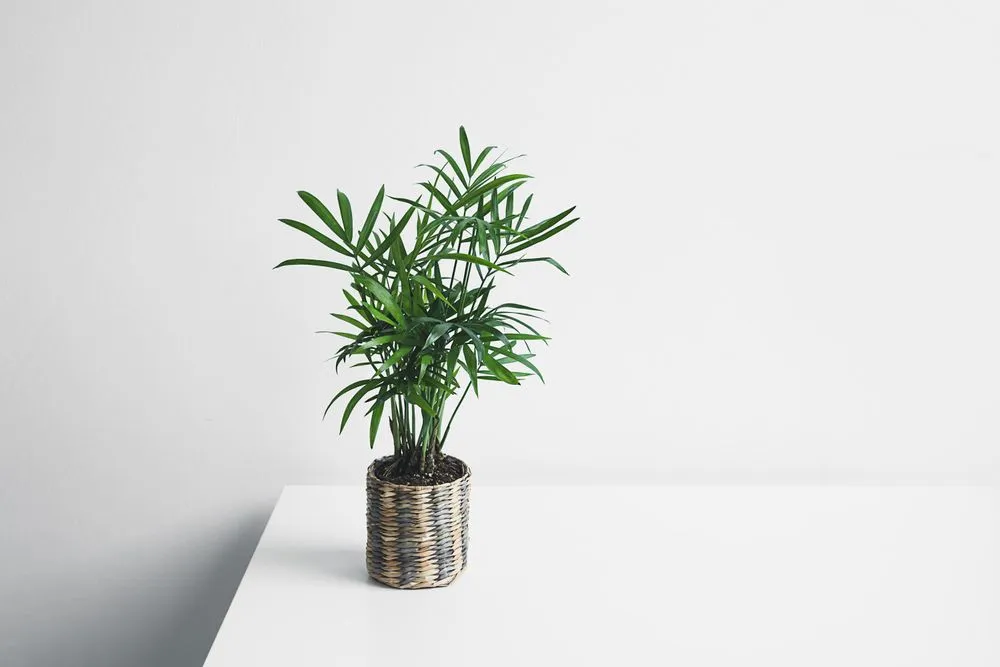
Bamboo Palm is one of the best plants for your office, bringing a lush, tropical feel to any workspace. With its tall, feathery fronds, it adds elegance while also serving as a natural humidifier, improving air quality and reducing dryness in office environments. This plant is particularly well-suited for spacious offices, where it can be used as a statement floor piece. Its ability to thrive in low to bright indirect light makes it a versatile choice for different office setups.
Care Tips:
- Light Requirements: Thrives in uniform low to bright indirect light. Avoid direct sunlight, which can scorch the leaves.
- Maintenance Level: Low; easy to care for with minimal attention.
- Watering: Keep the soil slightly moist but not soggy. Water when the top inch of soil feels dry.
- Soil: Prefers well-draining, nutrient-rich potting mix to support healthy root growth.
- Humidity: Naturally increases humidity, making it great for dry office environments. Occasional misting can help maintain leaf health.
- Temperature: Grows best in office temperatures between 65-80°F (18-27°C). Keep away from cold drafts and heating vents.
- Pruning: Trim brown or yellowing leaves to keep the plant looking fresh and vibrant.
- Pot Selection: Use a deep pot with drainage holes to support its tall growth and prevent water buildup.
- Cleaning: Wipe leaves occasionally to remove dust and enhance their natural shine.
- Pet-Friendly: Non-toxic to pets, making it a safe choice for offices with animals.
9. Philodendron
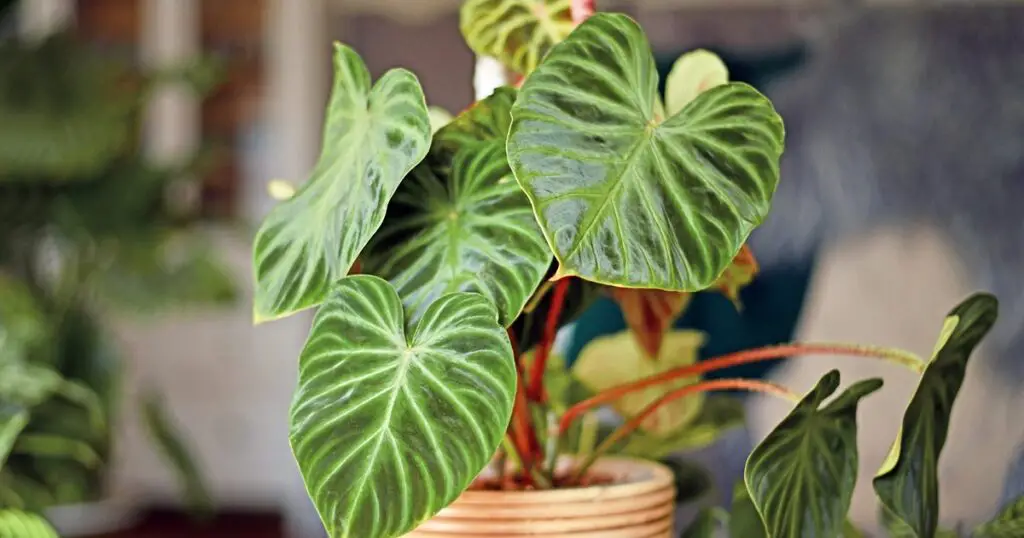
Philodendron is one of the best plants for your office, offering both beauty and versatility with its lush, vibrant foliage. Known for its adaptability, this plant thrives in various office environments, including those with limited natural light. Whether you choose a trailing variety to drape over shelves or an upright type for a bold statement, Philodendrons bring a refreshing, jungle-like feel to any workspace. Their easy-care nature makes them a favorite among plant lovers of all experience levels.
Care Tips:
- Light Requirements: Grows well in low to moderate indirect light. Avoid prolonged exposure to direct sunlight, which can scorch the leaves.
- Maintenance Level: Low; perfect for busy professionals who want a fuss-free plant.
- Watering: Water when the top inch of soil feels dry. Overwatering can lead to root rot, so ensure proper drainage.
- Soil: Prefers well-draining, nutrient-rich potting mix. A peat-based mix works well.
- Humidity: Thrives in moderate to high humidity but adapts well to standard office air.
- Temperature: Best suited for office temperatures between 65-80°F (18-27°C). Keep away from cold drafts and air conditioning vents.
- Pruning: Trim leggy vines or yellowing leaves to encourage bushier growth.
- Propagation: Easily propagated through stem cuttings placed in water or soil.
- Cleaning: Wipe leaves occasionally to remove dust and keep them glossy.
- Toxicity: Mildly toxic if ingested, so keep away from pets and small children in office settings.
10. Monstera Deliciosa

Monstera Deliciosa is one of the best plants for your office, offering a bold and sophisticated look with its iconic split leaves. Also known as the “Swiss Cheese Plant,” this tropical beauty makes an eye-catching statement in office spaces, bringing a fresh and modern touch. Though it requires slightly more care than smaller office plants, its stunning foliage and ability to thrive in indirect light make it a fantastic choice for work environments.
Care Tips:
- Light Requirements: Prefers bright, indirect light but can tolerate lower light conditions. Avoid direct sunlight, which may scorch the leaves.
- Maintenance Level: Moderate; requires occasional attention to keep it healthy and looking its best.
- Watering: Water when the top 2 inches of soil feel dry. Overwatering can cause root rot, so ensure proper drainage.
- Soil: Thrives in well-draining, nutrient-rich potting mix. Adding peat moss can improve moisture retention.
- Humidity: Prefers moderate to high humidity. Misting occasionally can help, especially in dry office environments.
- Temperature: Ideal for office temperatures between 65-80°F (18-27°C). Keep away from cold drafts and heating vents.
- Pruning: Trim damaged or yellowing leaves to promote healthy growth.
- Support: As it grows, Monstera may need a moss pole or stake to support its climbing habit.
- Cleaning: Wipe leaves regularly to remove dust and maintain their glossy appearance.
- Toxicity: Mildly toxic if ingested, so keep away from pets and small children in office spaces.
11. Aloe Vera
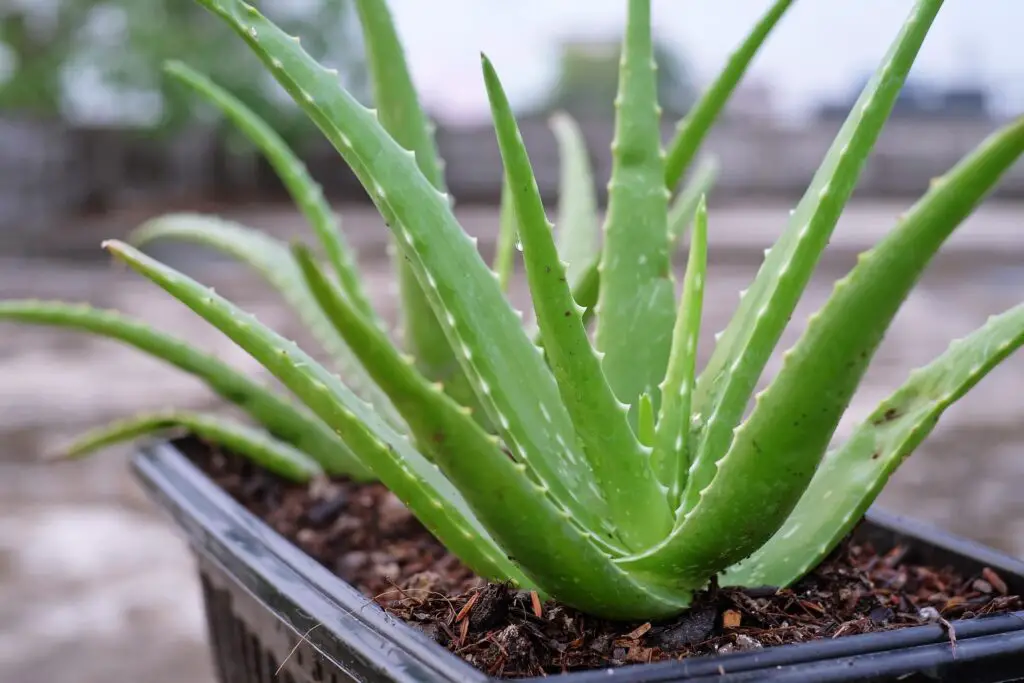
Aloe Vera is one of the best plants for your office, combining aesthetics with practical benefits. Known for its thick, fleshy leaves filled with soothing gel, this plant is not only a stylish addition to any workspace but also a natural remedy for minor burns and skin irritations. Its low-maintenance nature makes it an ideal choice for busy professionals, thriving with minimal care and infrequent watering.
Care Tips:
- Light Requirements: Prefers bright, indirect light. A sunny windowsill is the perfect spot, but it can tolerate some lower light conditions.
- Maintenance Level: Minimal; thrives on neglect and requires very little care.
- Watering: Water deeply but infrequently—about once every 2–3 weeks. Allow the soil to dry out completely between waterings.
- Soil: Requires well-draining cactus or succulent mix to prevent root rot.
- Humidity: Adapts well to dry office air; no additional misting needed.
- Temperature: Grows best in office temperatures between 65-80°F (18-27°C). Keep away from cold drafts.
- Pot Selection: Use a pot with drainage holes to avoid water buildup at the roots.
- Propagation: Easily propagated through offsets (baby plants) that can be removed and repotted.
- Cleaning: Wipe leaves occasionally to remove dust and maintain their healthy glow.
- Toxicity: Mildly toxic if ingested, so keep out of reach of pets and small children.
12. Calathea (Prayer Plant)
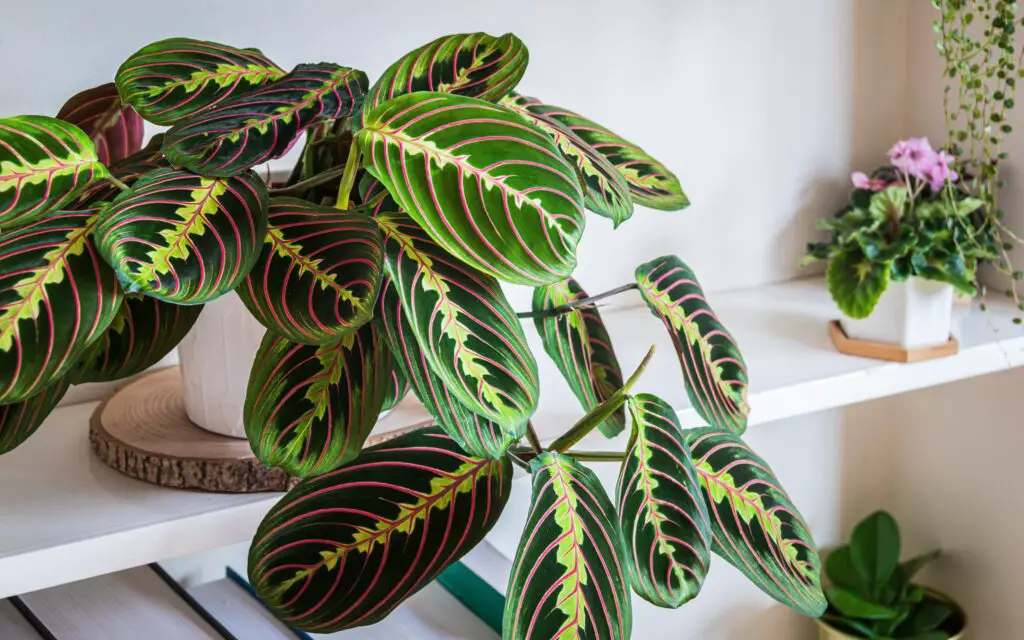
Calathea is one of the best plants for your office, known for its stunning, patterned foliage that adds a decorative touch to any workspace. Often called the “Prayer Plant” due to its fascinating habit of folding its leaves upward at night, this plant brings both beauty and movement to your office. While it requires a bit more attention than some other office plants, its unique appearance makes it a rewarding choice for plant lovers.
Care Tips:
- Light Requirements: Prefers low to medium indirect light. Avoid direct sunlight, which can fade its vibrant leaf patterns.
- Maintenance Level: Moderate; requires regular watering and humidity care.
- Watering: Keep the soil consistently moist but not soggy. Use distilled or filtered water, as Calatheas are sensitive to tap water chemicals.
- Soil: Thrives in well-draining, peat-based potting mix.
- Humidity: Loves high humidity—mist occasionally or place near a small office humidifier.
- Temperature: Ideal for office temperatures between 65-80°F (18-27°C). Keep away from cold drafts and air conditioning vents.
- Pruning: Trim damaged or yellowing leaves to maintain plant health.
- Cleaning: Wipe leaves gently to remove dust and maintain their vibrant colors.
- Pet-Friendly: Non-toxic to pets, making it a great choice for offices with animals.
13. Cactus

Cactus is one of the best plants for your office, especially for those who want a stylish, low-maintenance plant that thrives on neglect. These desert plants come in various shapes, sizes, and textures, making them fun, quirky additions to any workspace. Their ability to store water allows them to survive long periods without care, making them perfect for busy professionals who might forget to water their plants.
Care Tips:
- Light Requirements: Prefers bright, direct sunlight. Best placed on a sunny windowsill or under a grow light if natural light is limited.
- Maintenance Level: Very low; requires minimal care and occasional watering.
- Watering: Water sparingly—about once every 2–4 weeks, depending on the office temperature. Always let the soil dry out completely before watering.
- Soil: Use well-draining cactus or succulent mix to prevent root rot.
- Humidity: Thrives in dry office air and does not require misting.
- Temperature: Grows best in office temperatures between 65-80°F (18-27°C). Avoid placing near cold drafts or air conditioning vents.
- Pot Selection: Use a pot with drainage holes to prevent excess moisture buildup.
- Growth Potential: Small varieties are perfect for desks, while larger species can make unique statement pieces.
- Cleaning: Dust off spines occasionally to keep the plant looking fresh. Use a soft brush for hard-to-reach areas.
- Pet Safety: Some cacti have sharp spines, so be cautious in shared office spaces.
Why Add Plants to Your Office?
Bringing plants into the office isn’t just a trend—it’s a proven strategy for improving workplace morale and productivity. Studies have shown that plants reduce stress, enhance creativity, and even moderate office acoustics for quieter time when focusing on tasks. Plus, many office plants come with air-purifying benefits, removing common pollutants.
Key Benefits:
- Enhanced Focus: Greenery helps maintain focus and reduce mental fatigue.
- Air Purification: Many plants, like the Snake Plant and Peace Lily, improve indoor air quality.
- Boosted Creativity: Plants foster a happier mental state conducive to idea generation.
- Personal Touch: Adds personality to a bland workspace.
How to Choose the Best Plant for Your Office?
When selecting best plants for your office, keep these tips in mind:
- Assess Light Availability – Does your desk get direct sunlight, or is it in a darker corner?
- Estimate Maintenance – Choose a plant that aligns with your schedule and care preferences.
- Space Consideration – Opt for smaller plants for modest desks and larger ones for open areas.
- Health Benefits – Select plants that improve air quality or offer mood-boosting benefits.
Bringing greenery into your workspace can boost productivity, reduce stress, and improve air quality. These 13 Best Plants for Your Office offer a variety of options, from low-maintenance choices like the Snake Plant and ZZ Plant to visually stunning picks like the Monstera and Calathea. Whether you have a spacious office or a compact desk setup, there’s a plant that fits your needs.
Choosing from these 13 Best Plants for Your Office ensures that your workspace stays fresh, inviting, and full of natural beauty. With the right care, these plants will thrive in your office environment, adding a touch of greenery that enhances both aesthetics and well-being. So, pick your favorite and enjoy the benefits of having nature right at your desk!
FAQs:
1. Which office plants require the least maintenance?
The best low-maintenance office plants include the Snake Plant, ZZ Plant, and Cactus. These plants thrive on neglect, require minimal watering, and can tolerate low light conditions, making them perfect for busy professionals.
2. What are the best plants for low-light office spaces?
If your office has limited natural light, consider plants like the Snake Plant, Pothos, and ZZ Plant. These plants adapt well to low-light conditions and continue to grow even in dim environments.
3. How do office plants improve productivity and well-being?
Plants enhance air quality, reduce stress, and create a calming atmosphere, which can boost focus and productivity. Studies suggest that having greenery in the office leads to a more positive work environment and increased job satisfaction.

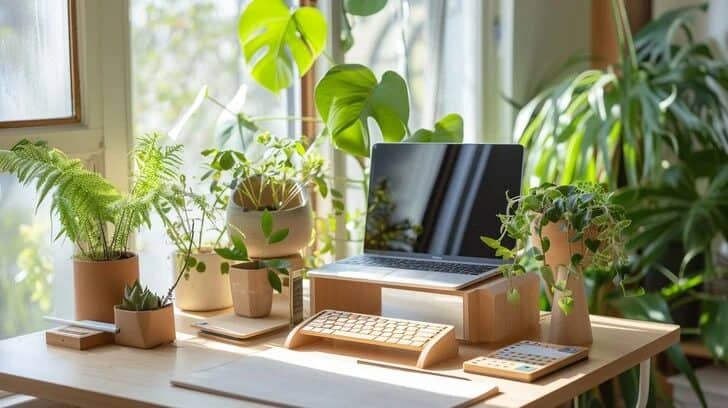
2 thoughts on “13 Best Plants for Your Office: Purify Your Workspace!”